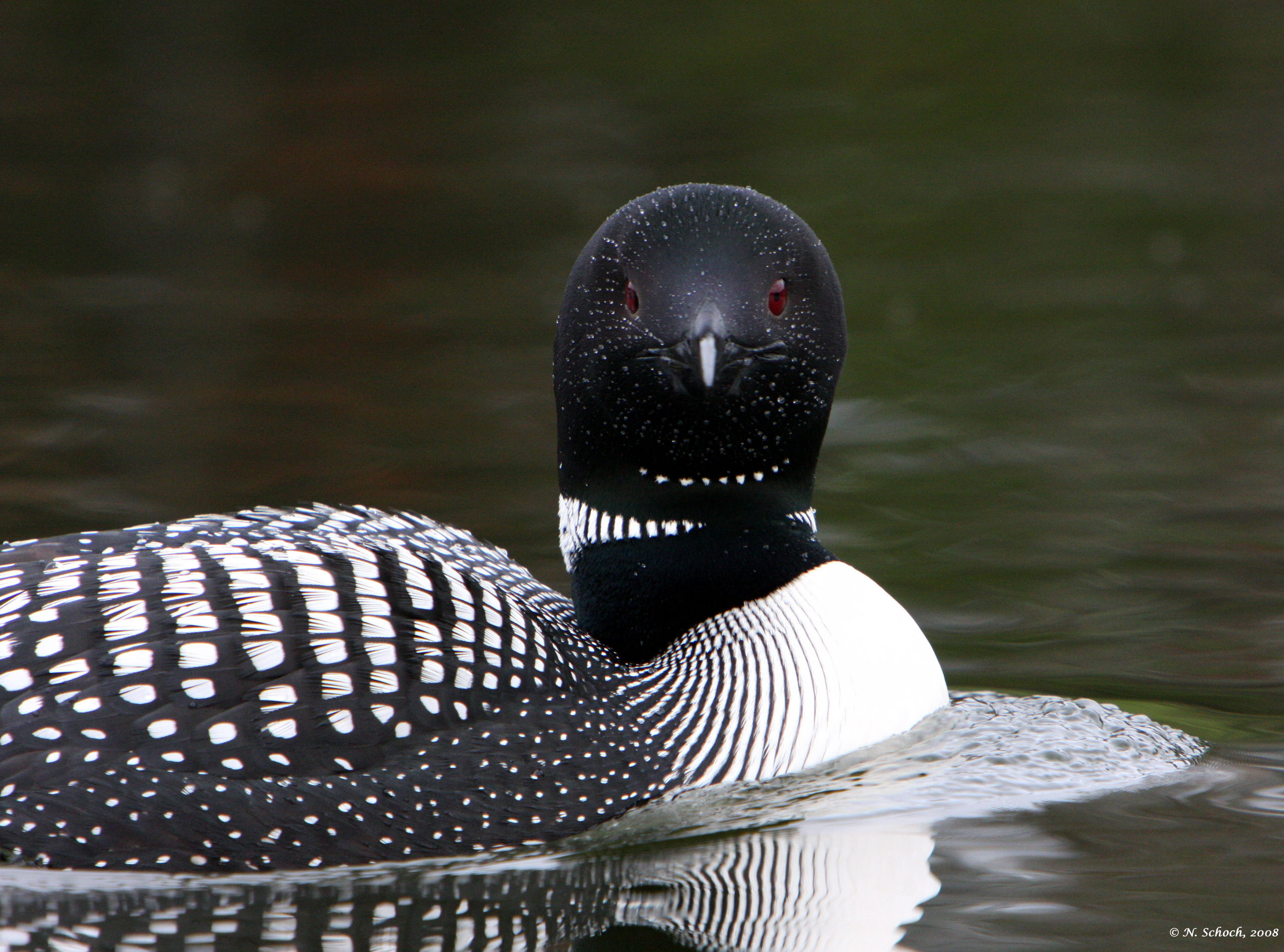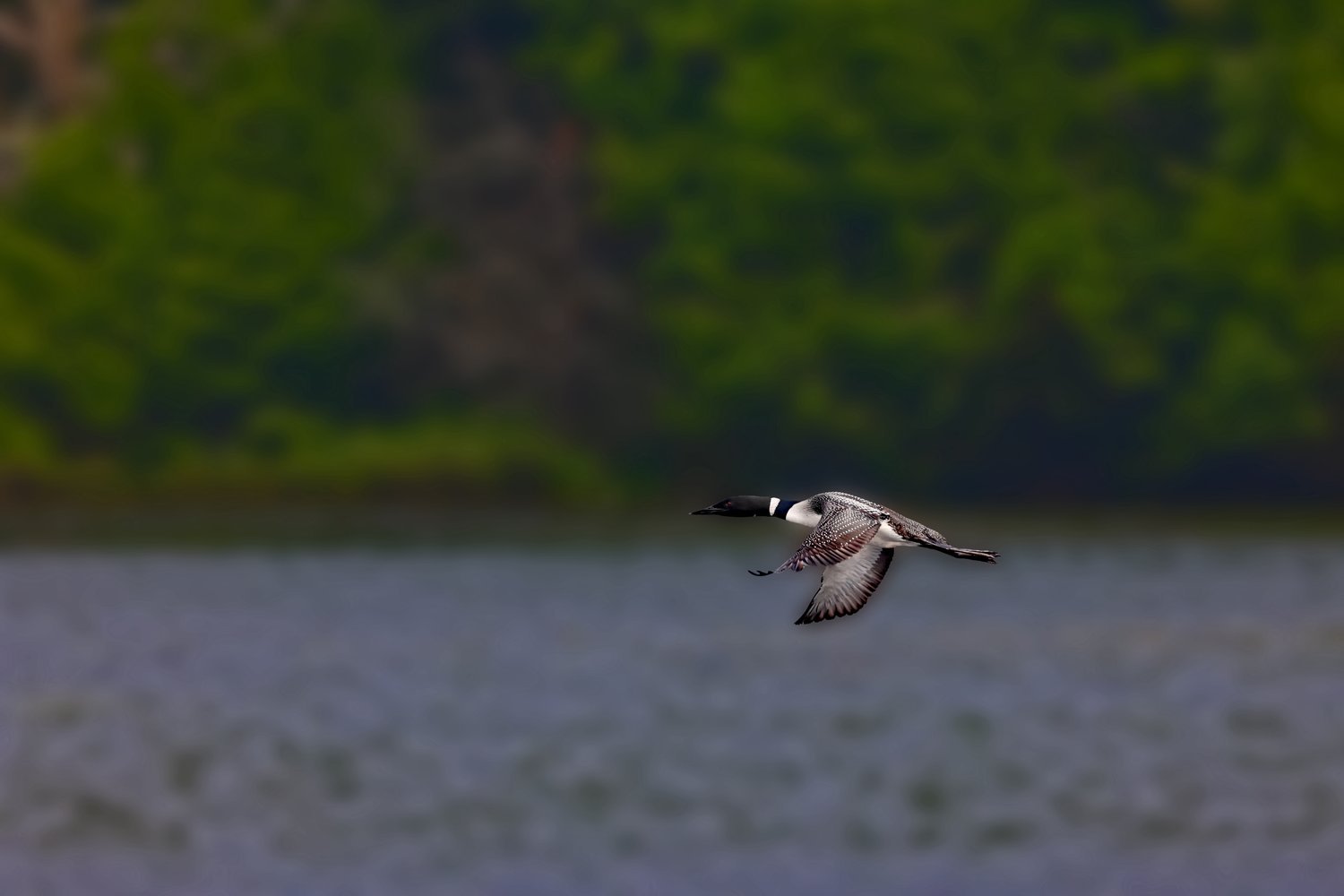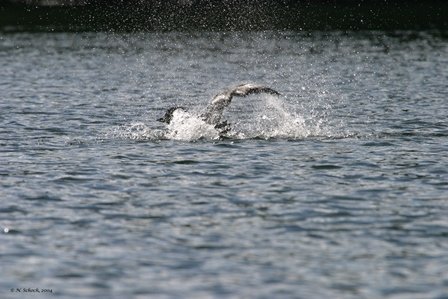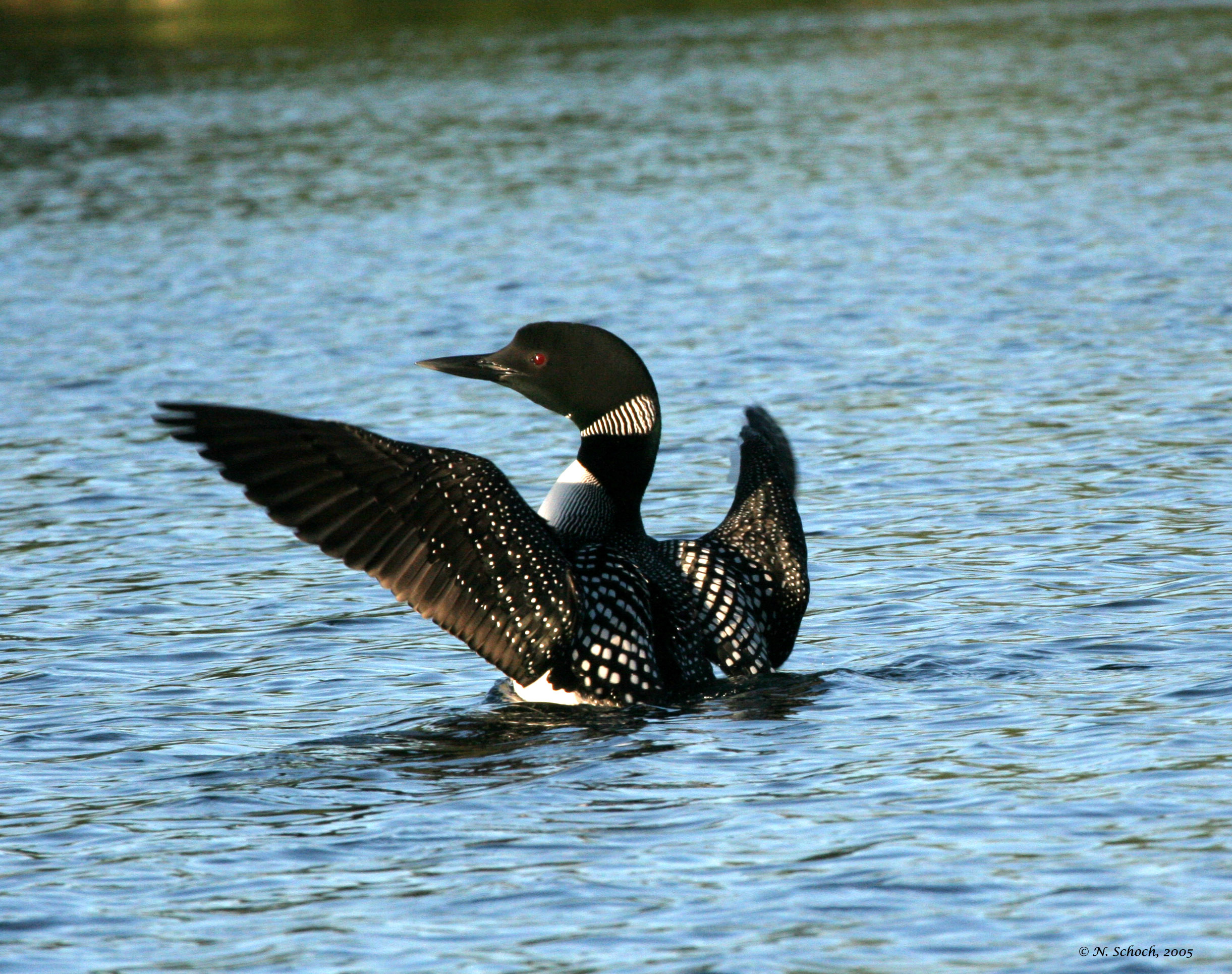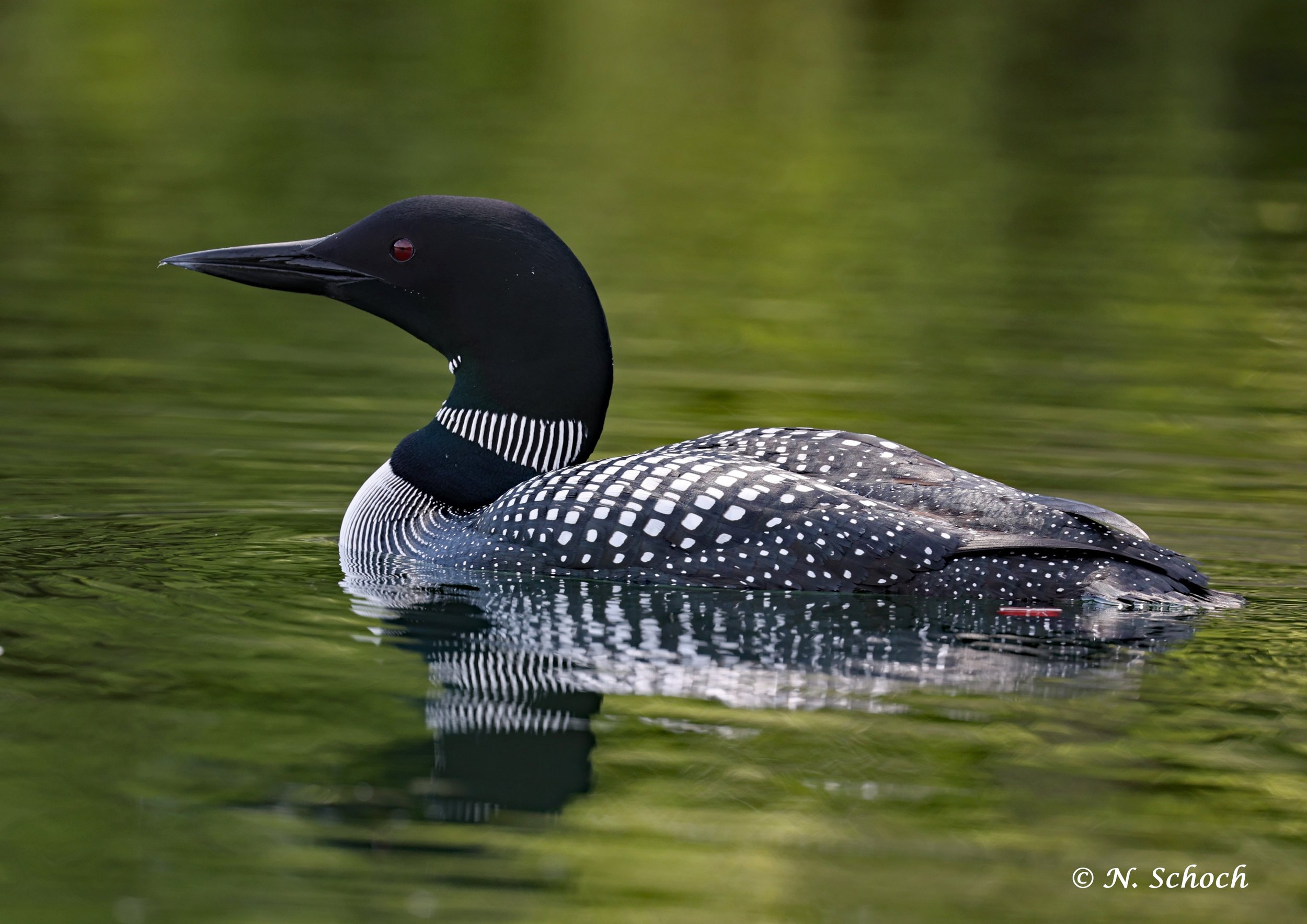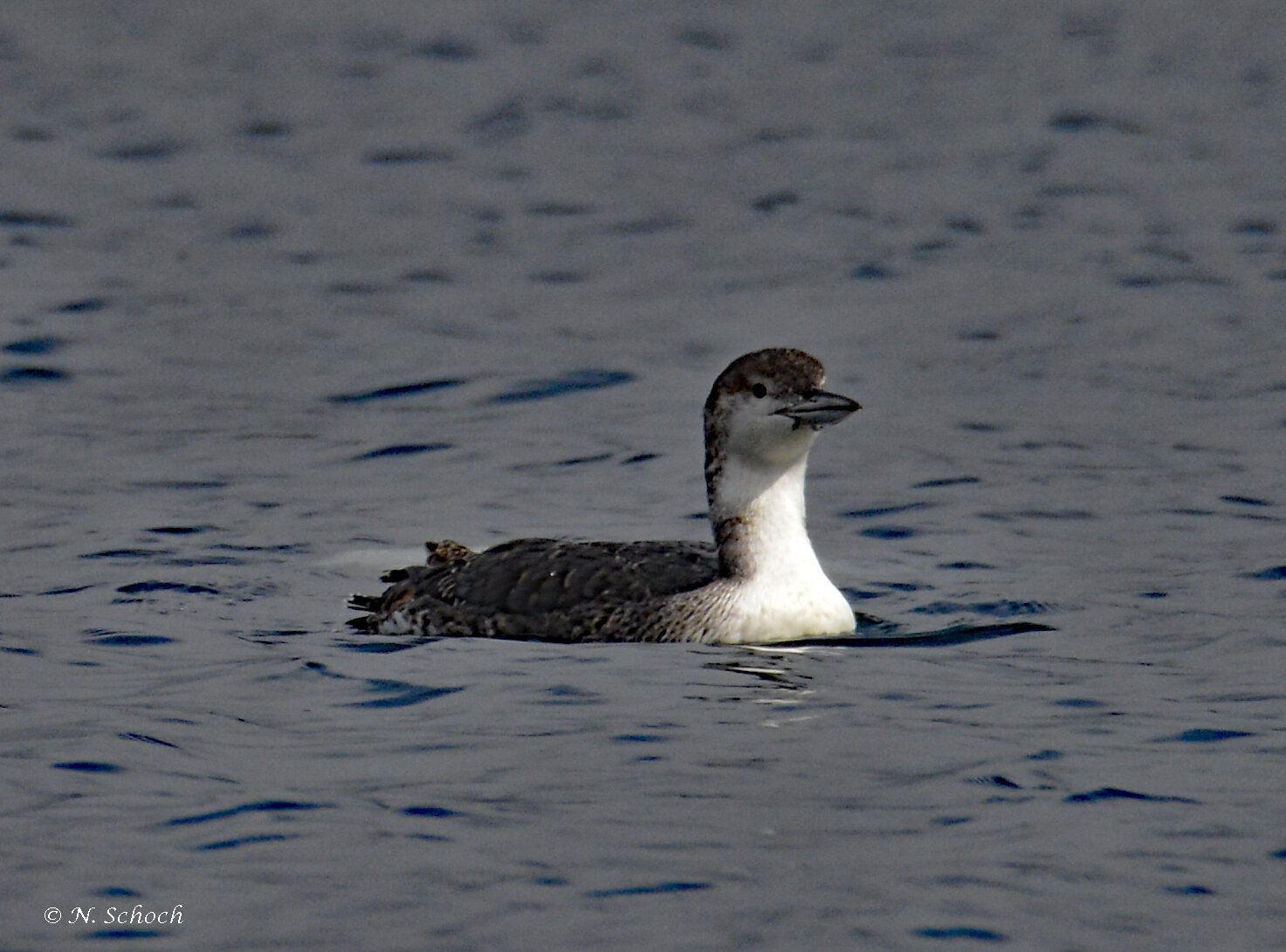The Common Loon (Gavia immer) is one of five species of the Gaviidae family, and it is the only loon species to breed in the northern United States. Three of the other species breed in northern North America on arctic waterbodies: Yellow-Billed (Gavia adamsii), Red-Throated (Gavia stellata) and Pacific loons (Gavia pacifica). These species are occasionally observed further south during migration. Arctic loons (Gavia arctica) live on waterbodies in northern Europe and Asia and look very similar to Pacific loons.
Modern loons have been found in the fossil record as early as the Eocene- about 35 million years ago. Their relatives in the Gaviiformes Order can be traced back to the Late Cretaceous period (65 million years ago). In prehistoric times, loons lived much further south than they do today. Their fossils have been found in California, Florida, and Italy. They are one of the oldest lineages of birds on Earth.
Species of Special Concern
Common Loons are a Species of Special Concern in New York State and are protected under the Federal Migratory Bird Treaty Act. Their populations face numerous threats, including environmental mercury pollution, shoreline development, fishing line entanglement, lead poisoning from ingestion of toxic fishing tackle, and human disturbance.
Loons live 20-30 years and are fish-eating birds at the top of the aquatic food web. They are a signature species for understanding environmental quality and the health of aquatic ecosystems on a regional and global scale.
Diet
Fresh and saltwater fish are the primary diet of Common Loons. However, both adults and juveniles also regularly eat crustaceans (especially crayfish) and aquatic invertebrates. During the summer, adults eat many species of freshwater fish, including yellow perch, suckers, shiners, and occasionally small trout. In the winter, loons shift their diet because they live in saltwater along the coast. Fish such as flounder and herring, as well as crustaceans, are regular components of their winter diet. Loons have a salt gland to excrete excess salt that they ingest while feeding on the ocean.
Loons are visual hunters, so they need relatively clear water conditions to find prey. Adults prefer to hunt in shallow water and eat whatever is easiest to catch and most abundant. Feeding dives are usually less than a minute, although if prey is hard to find, the dives can be longer.
Once a fish or other potential prey is located, the loon dives, holding its wings close to its body, and uses its powerful feet for propulsion while swimming underwater. The fish, crayfish, or other prey is captured in the loon’s bill, and with the exception of large fish, is consumed while still underwater. If the loon catches a large fish, it may release and catch the fish repeatedly until the fish is subdued and the loon can swallow it whole.
Loons also ingest small pea-sized stones to help them digest fish bones and the shells of crustaceans. An average of 10-20 stones are maintained in the gizzard, which grinds down the hard items to enable them to pass through the lower digestive tract easily.
HOW MUCH CAN A LOON EAT?
Loons typically eat fish weighing 10-70 grams. They usually eat the fish and other prey they catch underwater, although they will bring food to the surface to feed their chicks, and also large fish to subdue them before swallowing them. An adult loons eats approximately two pounds of food daily.
Adult birds, especially large adult males, occasionally catch a large fish (up to 250-300 grams). A big fish, such as a full-grown sucker, can take several minutes for a loon to subdue and swallow. The loon may drop the fish and dive after it repeatedly, stabbing at it again and again with its beak until the fish is subdued and can be eaten.
After swallowing a large fish, the loon may stretch its neck up and appear to yawn as it tries to move the fish down its throat. Such a big fish will cause a loon's neck to bulge out until the fish moves down into the stomach and is digested.
FEEDING THE CHICKS
Juvenile loons are fed fish appropriate to their size. Adults carry small minnows and sunfish, crayfish, and aquatic insects sideways in their bill to bring food to their chicks. The young birds often watch underwater as their parents are hunting and begin trying to catch small prey when they are ~4-6 weeks old. By the time they are in the immature feathered plumage, juveniles are capable of catching and eating larger items— up to several inches in length. However, they will continue to beg for food incessantly from the parents until the late fall, when the adults leave for the coast. Then the juveniles must fend for themselves.
Adaptations
Adult loons are highly specialized for swimming and diving, and thus well-suited for aquatic environments. Their bodies are streamlined and their legs are laterally flattened – both of these characteristics greatly help reduce resistance when swimming underwater. Loon bones are very dense, which helps them dive and stay underwater. To compensate for the added weight of extra dense bones, loons must flap their wings continuously when flying to remain airborne. They are unable to soar like many other birds, such as eagles.
Loons’ large webbed feet are used for propulsion and making quick turns while underwater. Their legs are positioned so far back on their body that they are virtually incapable of walking on land. Loons only come to land to breed, nest, defecate (occasionally), or when they are gravely ill or injured.
Loons require a long stretch of about a 100 yards (a whole football field!) worth of open water to run before taking off. Loons can become trapped during sudden freezes of lakes or when they accidentally land on the ground. Even if they are perfectly healthy in these scenarios, they are incapable of taking off.
Vocalizations (Calls)*
Common Loons are very territorial and have a set of unique vocalizations to communicate with their mate, chicks, and other loons. Calls are occasionally combined to convey more complex messages.
HOOT
A soft short contact call between birds. Adults will hoot to each other, and parents will hoot to chicks, enabling them to keep in touch with the other birds. This call is only made when the bird is calm.
TREMOLO
Often called the "laughing call" of the loon, the tremolo is actually an alarm call used in threatening situations, such as when a boat is approaching a chick or a nest too closely. It is also the “flight call,” heard when a loon is flying overhead, particularly if it is going over a lake with other loons on the water.
Tremolos are also used in the "night chorus," a virtual concert made by several loons during the night. Members of a pair will “duet” using tremolo calls mixed with wails.
CHICK BEGGING CALL
When hungry, a chick will peep and peck persistently at the parent's bill, encouraging the parent to hunt for food for the chick.
WAIL
A long, one, two, or three note call used in situations when loons want to move closer to one another. Parents wail to their chicks to encourage the chicks to leave the nest, approach the parents when they have food, or emerge from a hiding place.
YODEL
This call is made exclusively by male loons when they are defending a territory or fighting with other loons. Males will also yodel if a predator is seen, such as when an eagle flies overhead, or when a boat is approaching too closely to its chicks.
Yodeling males crouch flat to the water with their head and neck extended and the lower bill just over the water or raise up in a “vulture” position, which is similar to a penguin dance, except their head is pointed down instead of up.
CHICK DISTRESS CALL
Chicks call out almost continuously with peeps, yelps, and wails when they are separated from their parents. The adult birds respond by moving closer to the chicks, and may hoot or wail to contact the chick.
* Loon vocalizations kindly provided by Dr. Jay Mager, Ohio Northern University
Have you ever heard a loon call in your favorite movie? You might be surprised how often they get casted! Click the button at right to learn why Hollywood loves loons and the noises they make.
Displays & Behaviors
Loons also use body language to convey information. Most loon behaviors are related to basic survival skills, such as feeding, mating, territorial defense, and protection of their chicks. Understanding loon behavior will help you learn more about loons when you are watching these fascinating birds, while also making sure that you are not accidentally disturbing them.
CIRCLE DANCE
Loons will gather together in social groups to feed, especially late in the summer and fall. Sometimes they form a circle and take turns diving quickly, possibly chasing food. They hoot a lot during this “dance” and do many shallow dives.
BACKRIDING
Adult loons carry young downy chicks on their backs to keep them warm and safe from predators. The chicks snuggle into the thick soft down under the parents’ wings to stay warm. By the time a chick is three weeks old, it is getting too big to snuggle.
When you observe loons with chicks, please give them plenty of extra space so you don’t stress and disturb them. If they are constantly moving away from you, that is an indication that you are disturbing them, especially if they are also vocalizing with tremolos.
PEERING
Loons "peer" underwater to search for fish or to see what other loons are doing. Chicks will also peer to watch their parents catch fish.
FURROWED BROW
This position means that the loon is alert and slightly concerned by a possible threat, such as a predator, another loon, or human/boat.
HIDING POSITION
The loon rides very low (almost flat) on the water. This position, often used by juveniles when they feel threatened, provides camouflage from predators, and the bird is able to quickly dive to get away from a threat.
HANGOVER POSITION
This is a defensive behavior that a nesting loon does when a threat is coming too close to its nest for its comfort. While attempting to not be seen, this loon is also getting ready to slide off quickly into the water off its nest. If this happens repeatedly during incubation, it could cause the loons to permanently abandon their nest. When you see a loon in hangover position, you should immediately move much further away from the nest and maintain a large distance thereafter. Loons will resume an upright posture when they no longer feel threatened on the nest.
PENGUIN DANCE
This is an aggressive display, usually done by the male, to defend its territory or chicks from another loon, a predator, or a boat (both motorboats or ones that are paddled). This display is extremely energy intensive, and the bird may do it repeatedly until the threat moves away. Loons often yodel (males only) and tremolo when penguin dancing.
In early summer, you may see territorial battles with the resident loons penguin dancing at intruding loons to chase them from their territories.
WING ROWING
Loons will wing row to move quickly from one part of a lake to another by propelling themselves with their wings across the water. In territorial interactions, the loon being driven away will commonly wing row far away from the defender. Sometimes, the defender will chase the intruder away by wing rowing as well. During such a fight, there are also usually loud tremolos, yodels, and splashing, which creates quite a commotion! In instances where loons simply use wing rowing to travel across the lake and are not fighting, there is usually little to no calling.
SPLASH DIVING
A loon will quickly “splash dive” when it feels threatened – this is a very fast dive that is accompanied by a splash as the loon enters the water. The bird often squawks or yelps as it dives. If you see a loon splash diving, it is probably upset about something and is trying to get away.
Bathing and Preening
Loons take baths and preen regularly to keep their feathers clean and waterproof. While bathing, loons roll, splash water about, and wing flap repeatedly, which can be mistaken for a bird in distress. Baths can last a half-hour or more before the bird settles down and begins to preen in earnest.
Loons preen their feathers to keep them properly aligned for flight and waterproof for swimming and diving. A small gland, the uropygial gland, is located near the tail. This gland produces oil that the loon rubs on the surface of its feathers to keep them waterproof. Loons squeeze a bit of oil from the gland, then then spread it to feathers all over their body. Some places are quite difficult to reach, so loons are often seen craning their neck to reach every nook and cranny.
FOOT WAGGING
Occasionally, loons hold a foot above the surface of the water, especially when preening their white belly. They also “foot wag” to stretch their legs, regulate their body temperature, or just when they are relaxed and resting. If a loon is banded, it is easy to see the bands when it does a foot wag.
Plumage & Coloration
BREEDING PLUMAGE
During the breeding season, the black back of the Common Loon is "checker boarded" with a regular pattern of white spots, which contrasts sharply with its pure white underbelly. This checkerboard pattern resembles light reflecting off the water, and enables the loons to camouflage themselves from overhead predators. Similarly, the white underbelly acts as camouflage when viewed from underwater by blending in with the bright sky. A "necklace" of vertical white stripes graces the dark green/black neck, and a “chinstrap” of much smaller vertical white stripes is found just below the head. In breeding plumage, loons have a black bill and striking red eyes.
WINTER PLUMAGE
In the winter, loons have a much more drab plumage, with gray feathers replacing their characteristic black and white breeding plumage. Their necks and bellies remain white. This plumage provides excellent camouflage while they winter on the ocean or large reservoirs in the southern US. Loons keep their gray winter plumage from late October through early March.
When they molt back into their summer breeding plumage, loons also molt out their flight feathers from the previous year. Thus, they are completely flightless for about a month while on their wintering territory.
JUVENILE PLUMAGE
When chicks hatch, they have a downy black plumage that molts into a lighter brown color after three weeks. During this time, they are vulnerable to the elements and depend on their parents for warmth and protection from predators and the cold lake water. At nine weeks old, they molt once more into a gray juvenile plumage. During this second molt, they grow flight feathers and their thicker plumage keeps them warm and dry in the cold Adirondack lakes. At this time, they become more independent and begin to learn how to hunt and fly. The juvenile loons will keep this gray plumage until they reach maturity.
Interestingly, all the various plumage types are darker on the top and lighter on the bottom. This camouflage helps loon chicks blend in with the dark lakes when viewed from above by an eagle, and also with the bright sky when viewed from below by a fish or snapping turtle.
Socialization
In late summer and throughout the fall, loons are often observed congregating in social gatherings, consisting from a few individuals to dozens of birds (even 100 or more!). These social groups may serve to help with feeding, as there are many more eyes to look for fish and beaks to catch them. When in large groupings, loons have been observed feeding cooperatively by schooling fish in a manner similar to dolphins.
Loons are actually very social animals when they are not defending a territory or chicks. They gather together to feed, often doing a “circle dance,” in which the birds swim in a circle, taking turns peering and diving into the water. Vocalizations, primarily hoots, and ritualized displays such as bill dipping, wing rowing, and wing flapping, are regularly observed during these events.
During the summer, these groups generally consist of individuals that did not succeed in establishing a territory, did not successfully nest, or had chicks that did not survive. Occasionally a loon with chicks will leave its mate to care for the young while it goes off to feed and socialize. In the fall, juvenile birds also gather together in social groups prior to migration.
On wintering grounds, loons also group up in rafts of birds that are usually within a mile of the coastline. One of the largest rafts observed was of 700+ loons in Batavia Bay, Louisiana, in the Gulf of Mexico.
These loons are circle dancing, which is a group feeding strategy.
During the summer, loons live in small family groups that consist of a territorial pair and their chicks.
Loons are territorial during the summer months. This loon is wing rowing, which usually occurs during a territorial dispute with another loon.

